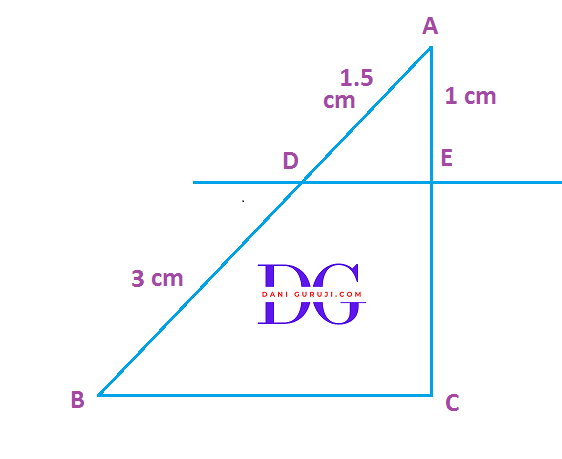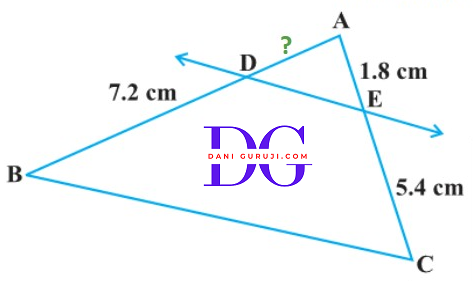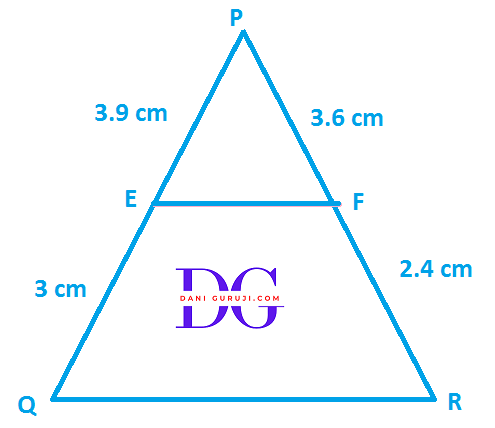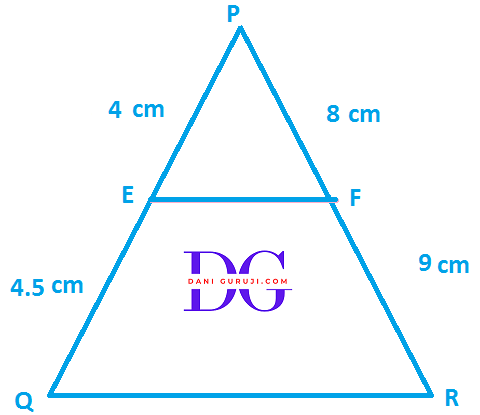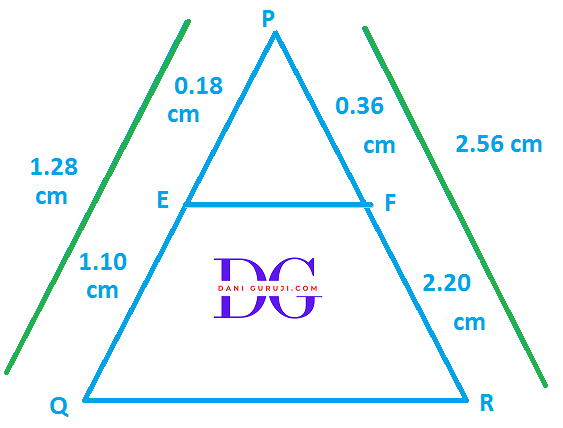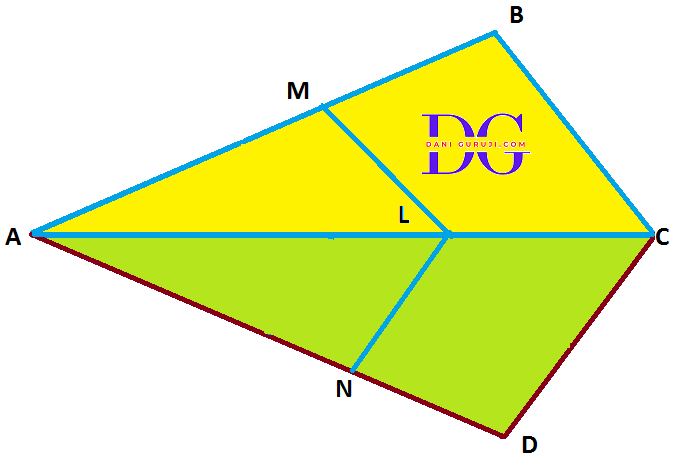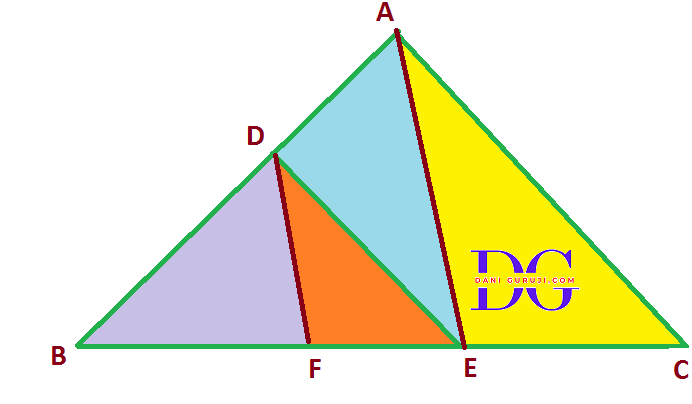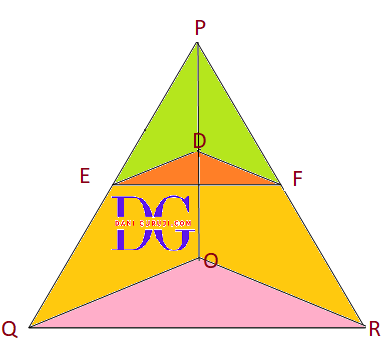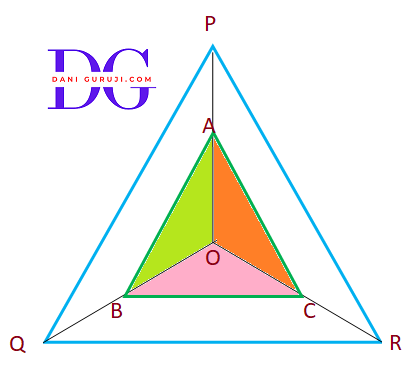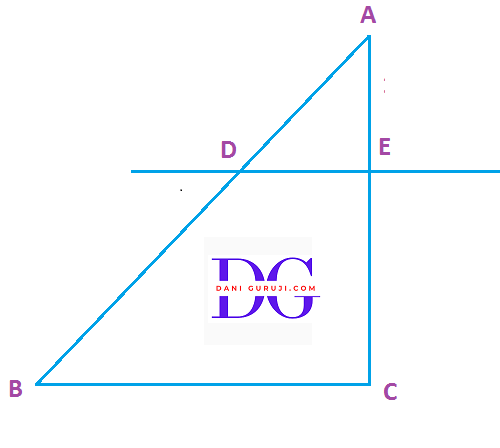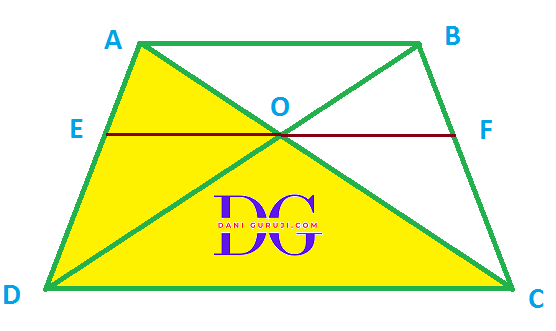In the following fig. (i)
(i)DE || BC.Find EC in (i)
Solution :
It is given that DE || BC
As per the Basic Proportionality Theorem (B.P.T) or Thales Theorem , we get
( If a line is drawn parallel to one side of a triangle to intersect the other two side in distinct points, the other two sides are divided in the same ratio )
$$ {AD \over BD} = {AE \over EC} $$
Putting the Values
$$⇒ {1.5 \over 3} = {1\over EC} $$
$$⇒ {1.5 × EC} = {3 × 1} $$
$$⇒ { EC} = {3 \over 1.5} $$
$$⇒ { EC} = {2} Cm. $$
Hence, EC = 2 cm.
In the following fig. (ii)
(ii) In ∆ABC, DE || BC, AD =?)
Solution :
It is given that DE || BC
As per the Basic Proportionality Theorem (B.P.T) or Thales Theorem , we get
( If a line is drawn parallel to one side of a triangle to intersect the other two side in distinct points, the other two sides are divided in the same ratio )
$$ {AD \over BD} = {AE \over EC} $$
Putting the Values
$$⇒ {AD \over 7.2} = {1.8\over 5.4} $$
$$⇒ {5.4 × AD} = {1.8 × 7.2} $$
$$⇒ { AD} = {{1.8 × 7.2} \over 5.4} $$
$$⇒ { AD} = {{18 × 72 × 10 } \over {54 × 100}} $$
$$⇒ { AD} = {2.4} Cm. $$
Hence, AD = 2.4 cm.
E and F are points on the sides PQ and PR respectively of a PQR For each of the following cases, state whether EF || QR:
(i) PE = 3.9cm. EQ = 3 cm,
PF=3.6cm. FR = 2.4 cm.
Solution :
It is given that
PE = 3.9cm., EQ = 3 cm, PF=3.6cm, FR = 2.4 cm.
As per the Converse of Basic Proportionality Theorem , we get
( We know that if a line divides any two sides of a triangle in the same ratio, then the line is parallel to the third side )
In order to prove EF || QR
We have to prove that
$$ {PE \over EQ} = {PF \over FR} $$
Here,
$${PE \over EQ} = {3.9 \over 3} = 1.3$$
$${PF \over FR} = {3.6 \over 2.4}= {1.5} $$
Hence, $$ {PE \over EQ} {\ne} {PF \over FR} $$
Therefore, EF is not parallel to QR.
E and F are points on the sides PQ and PR respectively of a PQR For each of the following cases, state whether EF || QR:
(ii) PE = 4 cm. QE = 4.5 cm.
PF = 8 cm. RF = 9 cm.
Solution :
It is given that
PE = 4 cm, QE = 4.5 cm, PF = 8 cm, RF = 9 cm.
As per the Converse of Basic Proportionality Theorem , we get
( We know that if a line divides any two sides of a triangle in the same ratio, then the line is parallel to the third side )
In order to prove EF || QR
We have to prove that
$$ {PE \over EQ} = {PF \over FR} $$
Here,
$${PE \over EQ} = {4 \over 4.5} = = {8 \over 9}$$
$${PF \over FR} = {8 \over 9} $$
Hence, $$ {PE \over EQ} = {PF \over FR} $$
According to converse of Basic Proportionality theorem, EF || QR Therefore, EF is parallel to QR.
E and F are points on the sides PQ and PR respectively of a PQR For each of the following cases, state whether EF || QR:
(iii) PQ = 1.28 cm. PR = 2.56 cm
PE = 0.18 cm. PF = 0.36 cm.
Solution :
It is given that
PQ = 1.28 cm. PE = 0.18 cm.
PE + EQ = PQ
⇒ EQ = PQ - PE
⇒ EQ = 1.28 - 0.18
⇒ EQ = 1.10 cm
Similarly
PF + FR = PR
⇒ FR = PR - PF
⇒ FR = 2.56 - 0.36
⇒ FR = 2.20 cm
As per the Converse of Basic Proportionality Theorem , we get
( We know that if a line divides any two sides of a triangle in the same ratio, then the line is parallel to the third side )
In order to prove EF || QR
We have to prove that
$$ {PE \over EQ} = {PF \over FR} $$
Here,
$${PE \over EQ} = {0.18 \over 1.10} = {1.8 \over 11}$$
$$⇒ {PE \over EQ} = {18 \over 110} = {9 \over 55}$$
and,
$${PF \over FR} = {0.36 \over 2.20} = {3.6 \over 22} $$
$$⇒ {PF \over FR} = {36 \over 220} = {9 \over 55} $$
Hence, $$ {PE \over EQ} = {PF \over FR} $$
According to converse of Basic Proportionality theorem, EF || QR Therefore, EF is parallel to QR.
In the following figure. If LM || CB and LN || CD, prove that
$ {AM \over AB} = {AN \over AD} $
Solution :
It is given that
In ∆ACB, LM || CB
As per the Basic Proportionality Theorem (B.P.T), we get
( If a line is drawn parallel to one side of a triangle to intersect the other two side in distinct points, the other two sides are divided in the same ratio )
$$⇒ {AL \over LC} = {AM \over MB} ........ (1) $$
Similarly
In ∆ACD, LN || CD
Therefore by Basic Proportionality Theorem
$$⇒ {AL \over LC} = {AN \over ND} ........ (2) $$
From equation 1 and 2, we get
$$ {AM \over MB} = {AN \over ND} $$
$$⇒ {MB \over AM} = {ND \over AN} $$
Adding 1 on both sides
$$⇒ {MB \over AM} + 1 = {ND \over AN} + 1 $$
$$⇒ {{MB + AM } \over AM} = {{ND + AN }\over AN} $$
$$⇒ {AB \over AM} = {AD \over AN} $$
$$⇒ {AM \over AB} = {AN \over AD} $$
Hence proved $ {AM \over AB} = {AN \over AD} $
In the following figure , DE ||AC and DF || AE. Prove that
$ {BF \over FE} = {BE \over EC} $
Solution :
It is given that
In ∆ABC, DE ||AC
As per the Basic Proportionality Theorem (B.P.T), we get
( If a line is drawn parallel to one side of a triangle to intersect the other two side in distinct points, the other two sides are divided in the same ratio )
$$⇒ {BD \over AD} = {BE \over EC} ........ (1) $$
Similarly
In ∆AEB, DF || AE
Therefore by Basic Proportionality Theorem
$$⇒ {BF \over FE} = {BD \over AD} ........ (2) $$
From equation 1 and 2, we get
$$ {BF \over FE} = {BE \over EC} $$
Hence proved $ {BF \over FE} = {BE \over EC} $
In the following figure, DE || OQ and DF || OR. Show that EF || QR.
Solution :
It is given that
In ∆POQ, DE || OQ
As per the Basic Proportionality Theorem (B.P.T), we get
( If a line is drawn parallel to one side of a triangle to intersect the other two side in distinct points, the other two sides are divided in the same ratio )
$$⇒ {PE \over EQ} = {PD \over DO} ........ (1) $$
Similarly
In ∆PRO, DF || OR
Therefore by Basic Proportionality Theorem
$$⇒ {PF \over FR} = {PD \over DO} ........ (2) $$
From equation 1 and 2, we get
$$ {PE \over EQ} = {PF \over FR} $$
In ∆PQR,
$$ {PE \over EQ} = {PF \over FR} $$
Using converse of Basic Proportionality Theorem
Line EF divides the ∆PQR in the same ratio
$$ ⇒ EF || QR $$
Hence proved
In the following figure, A, B and C are points on OP. OQ and OR respectively such that AB || PQ and AC || PR. Show that BC || QR.
Solution :
It is given that
In ∆POQ, AB || PQ
As per the Basic Proportionality Theorem (B.P.T), we get
( If a line is drawn parallel to one side of a triangle to intersect the other two side in distinct points, the other two sides are divided in the same ratio )
$$⇒ {OA \over AP} = {OB \over BQ} ........ (1) $$
Similarly
In ∆PRO, AC || PR
Therefore by Basic Proportionality Theorem
$$⇒ {OA \over AP} = {OC \over CR} ........ (2) $$
From equation 1 and 2, we get
$$ {OB \over BQ} = {OC \over CR} $$
In ∆OQR,
$$ {OB \over BQ} = {OC \over CR} $$
Using converse of Basic Proportionality Theorem
Line BC divides the ∆OQR in the same ratio
$$ ⇒ BC || QR $$
Hence proved
Using Theorem 6.1, prove that a line drawn through the mid-point of one side of a triangle parallel to another side bisects the third side. (Recall that you have proved it in Class IX).
Solution :
It is given that
In ∆ABC. D is the mid-point of AB.
Let DE is a line passing through the midpoint of line AB and parallel to line BC intersecting line AC at point E.
To Prove: DE bisects AC side at E.
In ∆ABC. D is the mid-point of AB.
Therefore $$ {AD = BD } $$
$$ {AD \over BD} = 1 $$
Now , In ∆ABC DE || BC
As per the Basic Proportionality Theorem (B.P.T), we get
( If a line is drawn parallel to one side of a triangle to intersect the other two side in distinct points, the other two sides are divided in the same ratio )
$$ {AD \over BD} = {AE \over EC} $$
$$ 1 = {AE \over EC} $$
$$ EC = AE $$
⇒ E is Mid Point of AC
Hence proved
Using Theorem 6.2, prove that the line joining the mid-points of any two sides of a triangle is parallel to the third side. (Recall that you have done it in Class IX).
Solution :
It is given that
In ∆ABC. D is the mid-point of AB.
To Prove: DE || BC.
In ∆ABC. D is the mid-point of AB.
Therefore, $$ {AD = BD } $$
$$ {AD \over BD} = 1 .....(i)$$
Similarly , In ∆ABC. E is the mid-point of AC.
Therefore, $$ {AE = EC} $$
$$ {AE \over EC} = 1 ....(ii)$$
From (i) and (ii)
$$ {AD \over BD} = {AE \over EC} = 1 $$
$$ {AD \over BD} = {AE \over EC} $$
As per converse of the Basic Proportionality Theorem (B.P.T) or converse of Thales Theorem , we get
( As we know that a line divides any two sides of a triangle in the same ratio, then the line is parallel to the third side )
⇒ DE || BC
Hence proved
ABCD is a trapezium in which AB || DC and its diagonals intersect each other at the point O. Show that $ {AO \over BO} = {CO \over DO} $ .
Solution :
It is given that
ABCD is a trapezium in which AB || DC and its diagonals intersect each other at the point O.
To Prove: $ {AO \over BO} = {CO \over DO} $
Construction : EF parallel to AB and CD ( EF||AB , EF||CD ) through point O.
In ∆ABC. .
⇒ $ FO||AB $ ( because Construction EF||AB)
As per the Basic Proportionality Theorem (B.P.T), we get
( If a line is drawn parallel to one side of a triangle to intersect the other two side in distinct points, the other two sides are divided in the same ratio )
$$⇒ {AO \over CO} = {BF \over CF} ..... (i) $$
Similarly , In ∆BCD
⇒ $ FO||CD $ ( because Construction EF||CD)
Therefore by Basic Proportionality Theorem
$$⇒ {BF \over CF} = {BO \over DO} ......(ii)$$
From (i) and (ii)
$$ {AO \over CO} = {BO \over DO} $$
$$ {AO \over BO} = {CO \over DO} $$
Hence proved
The diagonals of a quadrilateral ABCD intersect each other at the point O such that $ {AO \over BO} = {CO \over DO} $. Show that ABCD is a trapezium.
Solution :
It is given that
ABCD is a quadrilateral and its diagonals intersect each other at the point O.
$$ {AO \over BO} = {CO \over DO} $$
$$⇒ {AO \over CO} = {BO \over DO} ..... (i) $$
To Prove: ABCD is a trapezium
Construction : EF parallel to AB ( EF||AB ) through point O.
Now , In ∆ABC
⇒ $ FO||AB $ ( because Construction EF||AB)
Therefore by Basic Proportionality Theorem
$$⇒ {AO \over CO} = {BF \over CF} $$
From eq.(i)
$$⇒ {BO \over DO} = {BF \over CF} $$
Thus , In ∆BCD
The line segment FO divides the sides BD and BC in the same proportion
As per converse of the Basic Proportionality Theorem (B.P.T) or converse of Thales Theorem , we get
( As we know that a line divides any two sides of a triangle in the same ratio, then the line is parallel to the third side )
$$ FO||DC $$
But we know that FO||AB
Since we initially constructed $ FO||AB $, and we have now shown that $ FO||DC,$ it follows that $ AB||DC$
Therefore, Since one pair of opposite sides is parallel, the quadrilateral ABCD is a trapezium.
Syllabus for class 10
Advanced courses and exam preparation.
Previous Year Paper
Advanced courses and exam preparation.
Mock Test
Explore programming, data science, and AI.
